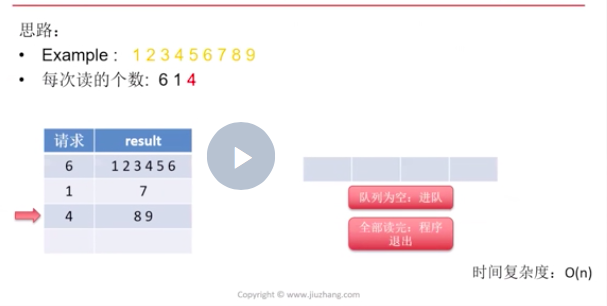[抄题]:
接口:int read4(char * buf)一次从文件中读取 4 个字符。
返回值是实际读取的字符数。 例如,如果文件中只剩下 3 个字符,则返回 3。
通过使用read4 接口,实现从文件读取 n 个字符的函数int read(char * buf,int n)。
[暴力解法]:
时间分析:
空间分析:
[思维问题]:
[一句话思路]:
buffer是缓冲区,buf是缓存。
[输入量]:空: 正常情况:特大:特小:程序里处理到的特殊情况:异常情况(不合法不合理的输入):
[画图]:
- 用数组实现队列的原理是:进入时是tail移动,出去时是head移动,形成模拟队列

[一刷]:
- i < n表示内存需求未被满足,head < tail就正常读取。入队时不需要i++,read4已带。
- head tail都要初始化为0
[二刷]:
[三刷]:
[四刷]:
[五刷]:
[五分钟肉眼debug的结果]:
[总结]:
buffer是缓冲区,buf是内存
[复杂度]:Time complexity: O(n) Space complexity: O(n)
[英文数据结构或算法,为什么不用别的数据结构或算法]:
数组,一次只能存4个,空间固定
[其他解法]:
[Follow Up]:
[LC给出的题目变变变]:
[代码风格] :

/* The read4 API is defined in the parent class Reader4. int read4(char[] buf); */ public class Solution extends Reader4 { /** * @param buf destination buffer * @param n maximum number of characters to read * @return the number of characters read */ char[] buffer = new char[4]; int head = 0; int tail = 0; public int read(char[] buf, int n) { int i = 0; while (i < n) { if (head == tail) { head = 0; tail = read4(buffer); if (tail == 0) { break; } } while (head < tail && i < n) { buf[i++] = buffer[head++]; } } return i; } }
